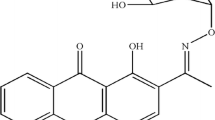Abstract
The anthracycline drugs adriamycin and daunorubicin, efficient in the treatment of various human cancers, form strong intercalation complexes with DNA. The therapeutic efficacy and toxicity of such anticancer drugs are governed by biochemical reactions of the core dihydroxy-9,10-anthraquinone unit. The high cost and toxic side effects of anthracycline drugs limit their use in cancer therapy. For a few decades, efforts have been made to find cheap, less toxic yet efficient analogues of anthracyclines. This work on 1,4-dihydroxy-9,10-anthraquinone (QH2), a simple analogue of the anthracyclines, was carried out to compare its biochemical properties with anthracyclines. UV-Vis and fluorescence spectroscopic methods were used to analyze interaction of the compound with calf thymus DNA. The data were used to evaluate the binding constant and site size.
Similar content being viewed by others
Abbreviations
- QH2 :
-
1,4-dihydroxy-9,10-anthraquinone
- ctDNA:
-
calf thymus DNA
References
Hardman, J.G., Gilman, A.G., Limbird, L.E.: Goodman and Gilman’s The Pharmacological Basis of Therapeutics, 9th edn. McGraw-Hill, New York (1996)
Reszka, K., Kolodziejczyk, P., Hartley, J.A., Wilson, W.D., Lown, J.W.: Anthracycline and Anthracenedionebased Anticancer Agents. Elsevier, Amsterdam (1998)
Eriksson, M., Nordbn, B., Eriksson, S.: Anthracycline-DNA interactions studied with linear dichroism and fluorescence spectroscopy. Biochemistry 27, 8144–8151 (1988)
Li, N., Ma, Y., Yang, C., Guo, L., Yang, L.: Interaction of anticancer drug mitoxantrone with DNA analyzed by electrochemical and spectroscopic methods. Biophys. Chem. 116, 199–205 (2005)
Banerjee, T., Mukhopadhyay, R.: Structural effects of nogalamycin, an antibiotic antitumor agent, on DNA. Biochem. Biophys. Res. Commun. 374, 264–268 (2008)
Dutta, P.K., Hutt, J.A.: Resonance Raman spectroscopic studies of adriamycin and copper(II)-adriamycin and copper(II)-adriamycin-DNA complexes. Biochemistry 25, 691–695 (1986)
Beraldo, H., Gurnier-Suillerot, A., Tosi, L., Lavelle, F.: Iron(III)-adriamycin and iron(III)-daunorubicin complexes: physicochemical characteristics, interaction with DNA, and antitumor activity. Biochemistry 24, 284–289 (1985)
Kellogg, G.E., Scarsdale, J.N., Fornari, F.A.: Identification and hydropathic characterization of structural features affecting sequence specificity for doxorubicin intercalation into DNA double-stranded polynucleotides. Nucleic Acids Res. 26, 4721–4732 (1998)
Zhang, H.M., Li, N.Q.: Electrochemical studies of the interaction of adriamycin to DNA. J. Pharm. Biomed. Anal. 22, 67–73 (2000)
Lown, J.W., Sim, S.-K., Majumdar, K.C.: Strand scission of DNA by bound adriamycin and daunorubicin in the presence of reducing agents. Biochem. Biophys. Res. Commun. 76, 705–710 (1977)
Ferrans, V.J.: Overview of cardiac pathology in relation to anthracycline cardiotoxicity. Cancer Treat. Rep. 62, 955–961 (1978)
Abraham, R., Basser, R.L., Green, M.D.: A risk-benefit assessment of anthracycline antibiotics in antineoplastic therapy. Drug Safety 15, 406–429 (1996)
Stathopoulos, G.P., Malamos, N.A., Dontas, I., Deliconstantinos, G., Perrea-Kotsarelis, D., Karayannacos, P.E.: Inhibition of adriamycin cardiotoxicity by 5-fluorouracil: A potential free oxygen radical scavenger. Anticancer Res. 18, 4387–4392 (1998)
Guin, P.S., Das, S., Mandal, P.C.: Electrochemical reduction of sodium 1,4-dihydroxy-9,10-anthraquinone-2-sulphonate in aqueous and aqueous dimethyl formamide mixed solvent: A cyclic voltametric study. Int. J. Electrochem. Sci. 3, 1016–1028 (2008)
Guin, P.S., Das, S., Mandal, P.C.: Sodium 1,4-dihydroxy–9,10-anthraquinone–2-sulphonate interacts with calf thymus DNA in a way that mimics anthracycline antibiotics: An electrochemical and spectroscopic study. J. Phys. Org. Chem. 23, 477–482 (2010)
Priebe, W.: Targeting DNA with anthracyclines: the importance of the sugar moiety. Molecules 5, 299–301 (2000)
Guin, P.S., Das, S., Mandal, P.C.: Studies on the formation of a complex of Cu(II) with sodium 1,4-dihydroxy–9,10-anthraquinone–2-sulphonate—An analogue of the core unit of anthracycline anticancer drugs and its interaction with calf thymus DNA. J. Inorg. Biochem. 103, 1702–1710 (2009)
Guin, P.S., Das, S., Mandal, P.C.: Formation and characterization of Ni(II) complex of sodium 1,4-dihydroxy–9,10-anthraquinone–2-sulphonate, an analogue of the core unit of anthracycline antibiotics, by different spectroscopic techniques. Int. J. Pure Appl. Chem. 3, 283–290 (2008)
Toshima, K., Ouchi, H., Okazaki, Y., Kano, T., Moriguchi, M., Matsumura, S., Asai, A.: Artificial anthraquinone-carbohydrate hybrids: Design, synthesis, DNA binding and cytotoxicity. Angew. Chem. 36, 2748–2750 (1997)
Warburg, O., Christian, W.: Isolation and crystallization of enolase. Biochem. Z. 310, 384–421 (1942)
Chakraborti, S., Bhattacharyya, B., Dasgupta, D.: Interaction of mithramycin and chromomycin A3 with d(TAGCTAGCTA)2: Role of sugars in antibiotic-DNA recognition. J. Phys. Chem. B 106, 6947–6953 (2002)
Mir, M.A., Majee, S., Das, S., Dasgupta, D.: Association of chromatin with anticancer antibiotics, methramycin and chromomycin A 3. Bioorg. Med. Chem. Lett. 11, 2791–2801 (2003)
Cantor, C., Schimmel, P.R.: Biophysical Chemistry, vol. 2. Freeman, San Francisco (1980)
Takenaka, I., Ihara, T., Takagi, M.: Bis-9-acridinyl derivative containing a viologen linker chain: electrochemically active intercalator for reversible labeling of DNA. J. Chem. Soc. Chem. Commun. 1485–1487 (1990)
Long, E.C., Barton, J.K.: On demonstrating DNA intercalation. Acc. Chem. Res. 23, 271–273 (1990)
Pyle, A.M., Rehmann, J.P., Meshoyrer, R., Kumar, C.V., Turro, N.J., Barton, J.K.: Mixed-ligand complexes of ruthenium(II): factors governing binding to DNA. J. Am. Chem. Soc. 111, 3051–3058 (1989)
Lakowicz, J.R.: Principles of Fluorescence Spectroscopy, pp. 239–240. Kluwer Academic, New York (1999)
Zhong, W., Yu, J.S., Huang, W.L., Ni, K.Y., Liang, Y.Q.: Spectroscopic studies of interaction of chlorobenzylidine with DNA. Biopolymers 62, 315–323 (2001)
Frezard, F., Garnier-Suillerot, A.: Comparison of anthracycline derivatives to purified DNA and to cell nuclei. Biochim. Biophys. Acta 1036, 121–127 (1990)
Author information
Authors and Affiliations
Corresponding author
Rights and permissions
About this article
Cite this article
Guin, P.S., Das, S. & Mandal, P.C. Interaction of 1,4-Dihydroxy–9,10-Anthraquinone with Calf Thymus DNA: A Comparison with Anthracycline Anticancer Drugs. J Solution Chem 40, 492–501 (2011). https://doi.org/10.1007/s10953-011-9654-x
Received:
Accepted:
Published:
Issue Date:
DOI: https://doi.org/10.1007/s10953-011-9654-x




